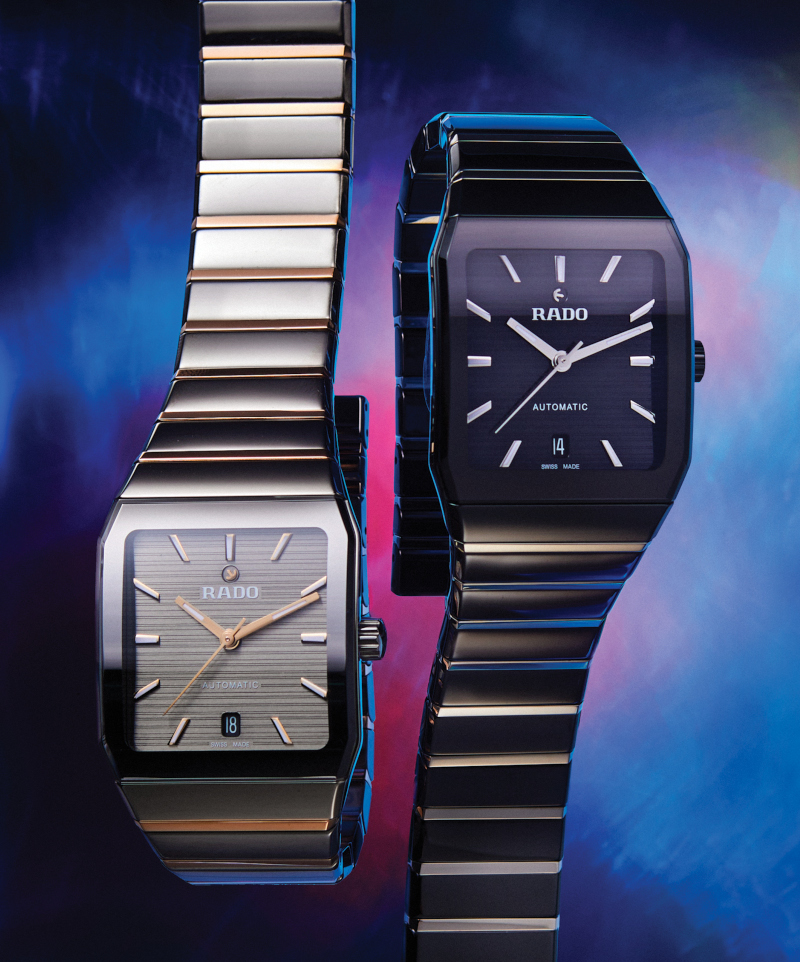
PHOTOGRAPHY SOON LAU / AWESOME IMAGE STUDIO
ART DIRECTION SARAH SAW
Nostalgia is a powerful thing. So powerful, in fact, that there has been an overwhelming demand for reboots and revivals all over popular culture. Childhood cartoons are getting modern overhauls, computer games are seeing remakes, motorcycles and home appliances are taking their design cues from the past and more relevant to this magazine, watches are looking into their archives for inspiration. This fondness for the past, or rather, our memories of the past, is an undeniable generator of strong emotional responses. And in an industry like luxury watchmaking, where everything hinges on the emotional rather than the practical, it doesn’t come as quite a surprise when brands lean into their past to inspire their future.
The contemporary watchmaking industry has always been inspired by its history, taking mechanical watchmaking principles that have existed for centuries, to create miniature machines for the modern consumer, and along the way refining and updating these timekeeping devices with modern sensibilities. Rado is one of those brands that evoke a sense of nostalgia for many, especially in Malaysia. In the early 2000s, the scratchproof properties of the watch were the driver of its popularity, but it was not the dive-watch silhouette of the Captain Cook that many remember from the past, because the Captain Cook, one of the more popular Rado collections today, was only revived in 2017. In the early 2000s, it was actually the rectangular shapes of Rado watches that drove this sense of nostalgia. And in 2023, Rado revived one of these geometrical shapes born in the very retro year of 1983, and it was the Anatom.
Just in time for the 40th anniversary of the Anatom, Rado relaunched the collection in December of 2023. At the time, however, the watch came with Rado’s signature high-tech ceramic case, but it was paired with a rubber strap. I thought the pairing was slightly odd for a debut, as the original Diastar Anantom (more on the naming conventions later) did come with a hardmetal (tungsten carbide) case and a stainless-steel bracelet. Last year, I had the chance to chat with Rado’s CEO, Adrian Bosshard, and when I brought this ceramic-rubber pairing, he assured me that it wouldn’t be the case for long. Lo and behold, recently Rado finally unveiled the Anatom with a ceramic bracelet to match, and it absolutely deserves its spot on the cover
So, where does the Anatom come from? To answer that question, we have to go back in time, back to 1983, when the mechanical watch industry was on the brink of collapse. The creation and proliferation of quartz movements threatened the very existence of their mechanical counterparts, rendering them almost obsolete. However, even before the advent of quartz, Rado was already working hard to solve another problem in watchmaking, scratch resistance.
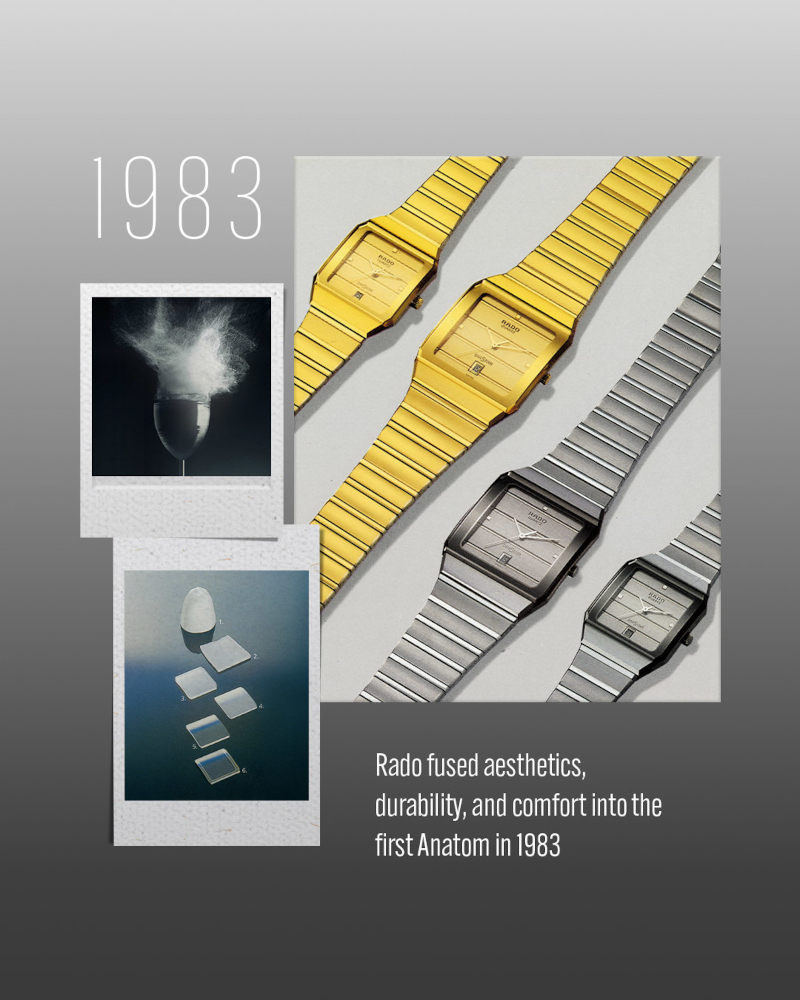
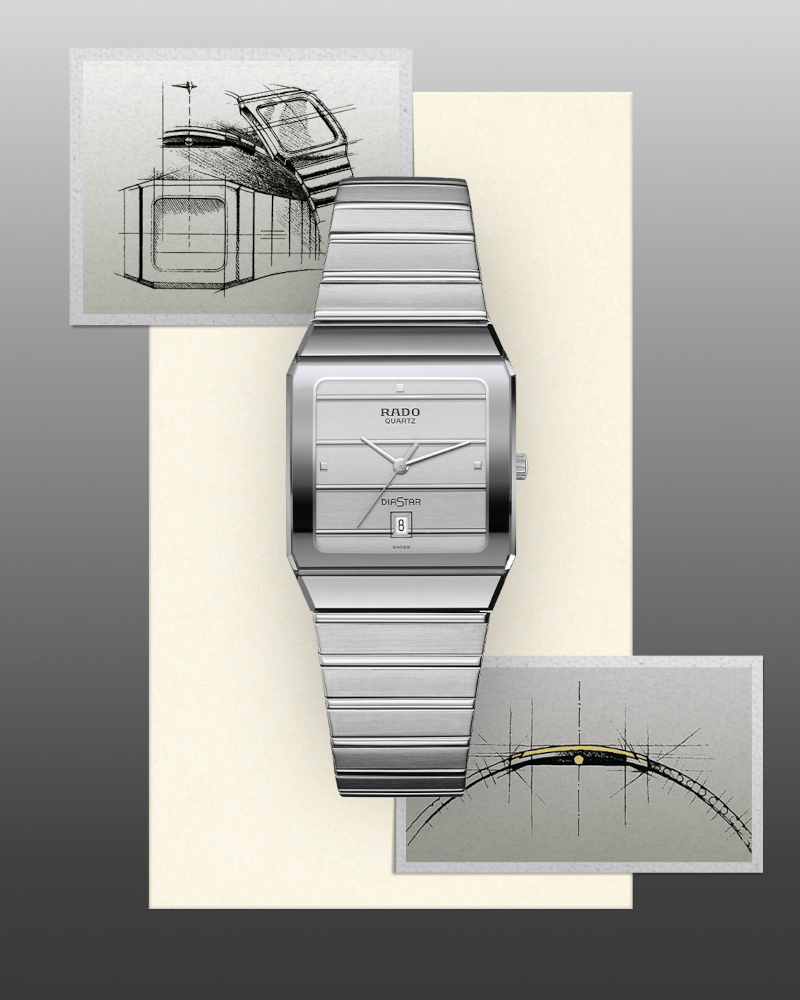
In the annals of watchmaking history, Rado has built a name for itself in its quest for robust, reliable and scratch-proof materials. The Diastar, for example, made its debut in 1962 and with it, a new hardmetal case, which we know to be tungsten carbide. At launch, the spiel for the Diastar was that it was near unscratchable, meaning that the new shiny, gleaming watch that you have just spent money on will stay perfectly shiny even with years of use. Building upon this quest for ultimate scratch-resistance is the reason that most of Rado’s best-selling watches today are clad in high-tech ceramic.
The Anatom, however, was born several years after the debut of the Diastar. In 1983, the first Anatom watch was launched under the Diastar collection, as it too had an ethos of being scratchproof. The difference, however, was that the Anatom was designed to prioritise human comfort. A watch that was meant to harmoniously meld with the user’s wrists as it was worn. To achieve this, the Anatom, which got its name from the word ‘anatomical’, was designed with a curved case and a fluid metal bracelet that would hug the circumference of the human wrist.
Even these days, with the watch industry being where it is, seeing a curved case on a watch is rare. Back in the 1980s however, the curved profile on the Anatom, was considered damn near futuristic. In fact, that was this futuristic approach that gave birth to the Anatom. Taking its original inspiration from anatomical, one finds the word atomic cleverly nestled in between. The zeitgeist at the time was one of optimism, of flying cars and space travel, and so the glossy exterior and the sleek build of the watch fit right in. Even the predecessor of the Anatom was given a sci-fi-ish name, V2200. But in the end, they settled with the name Anatom.
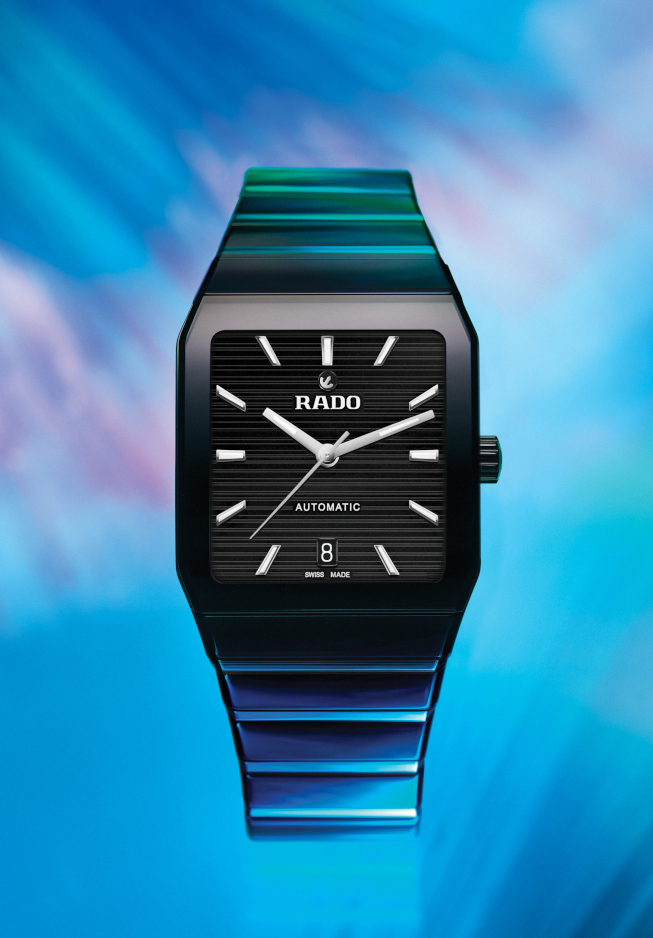
It was not easy to achieve this curved profile back in 1983, considering that Rado was working with a hardmetal like tungsten carbide for the case. Back then, it was hard enough to mill the hardmetal into the specific wrist-hugging shape, and the technology wasn’t near ready to create the bracelet in the same hardmetal material, so Rado decided to stick with stainless steel for the bracelet. Around this time, Rado also began using synthetic sapphire crystals, which were fast becoming harder than the metals used on watch cases. Therefore, there was no more need to protect the normally fragile crystals on the watch, and if you look at the early Anatom designs, these sapphire crystals were cleverly employed as part of the case, giving it an edge-to-edge crystal design. The tricky bit here is that these sapphire crystals were practically indestructible and as hard as the case, so Rado had to develop special diamond tools (which are harder than sapphire) to mill and shape their crystals.
The measure of success for the Anatom design philosophy is well presented in the telling of its story. It began as an offshoot of the Diastar collection, and over time, the clarity and character of the name Anatom could stand on its own.
Circling back to the contemporary obsession with all things retro, the fact that you can still find vintage Anatom watches in relatively great condition is one thing, but of course, reliability and serviceability, as with all vintage watches, remain a concern. Thankfully, just recently, Rado had decided to dust off the blueprints and revive this collection. “For its recent line of scratchproof DiaStar watches, the company succeeded in creating a shape conforming to the human anatomy. The collection is known as Rado DiaStar Anatom. Nomen est Omen,” reads the early promotional material for the Anatom. The Latin term Nomen est Omen roughly translates to, the name predicts the future. And fulfilling this prophecy, if you walk into a Rado store today, more than 40 years after the birth of the Anatom, a new reference of this watch still sits gleaming behind the display glass.
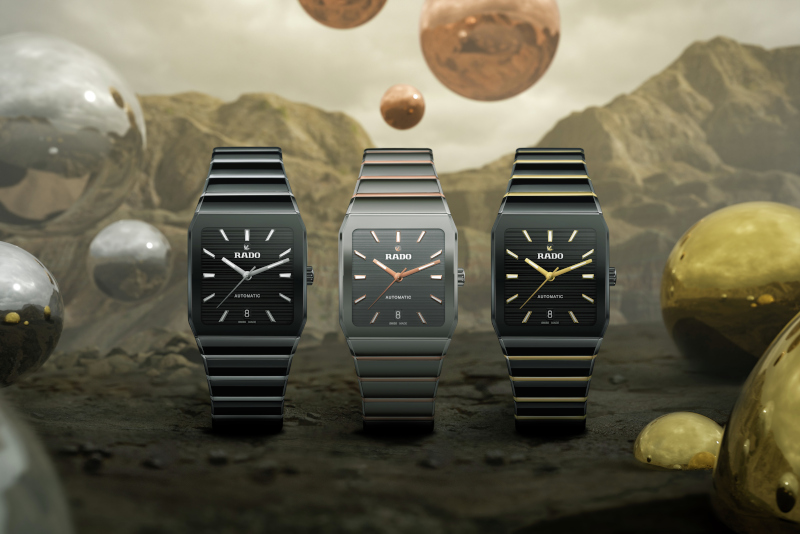
In December of 2023, the Rado Anatom was revived. And of course, the revival brought with it all the modern updates expected from a luxury watch brand of today. At a quick glance, the most obvious update to the Anatom comes in the form of a slightly larger case size, moving from a width of 28 mm to 32.5 mm. This slightly bigger case also hides the most important update to the Anatom, which exchanges Rado’s old hardmetal construction with their modern signature, high-tech ceramic. Although the hardness of the hardmetal and high-tech ceramic can be considered quite similar, there are many other benefits to ceramic, like its lighter weight and even its hypoallergenic properties, which allow it to become even more a part of the human anatomy than ever before.
Interestingly enough, the process of making high-tech ceramics doesn’t differ greatly from how they used to make the hardmetal case. The raw form of both cases starts from a powdered material, which is pressure moulded into its desired shape before being sintered at high temperatures, transforming it into the final product. While hardmetals were limited in colours, high-tech ceramics, on the other hand, could incorporate a variety of pigments. For example, Rado’s True Round Thinline Les Couleurs™ Le Corbusier collection is a great representation of the kinds of vivid hues that can be achieved with ceramic. As of now, the Anatom is available in a stately black ceramic case and for the fans who simply love the shine of hardmetals, the Anatom is also available with the brand’s proprietary plasma high-tech ceramic material.
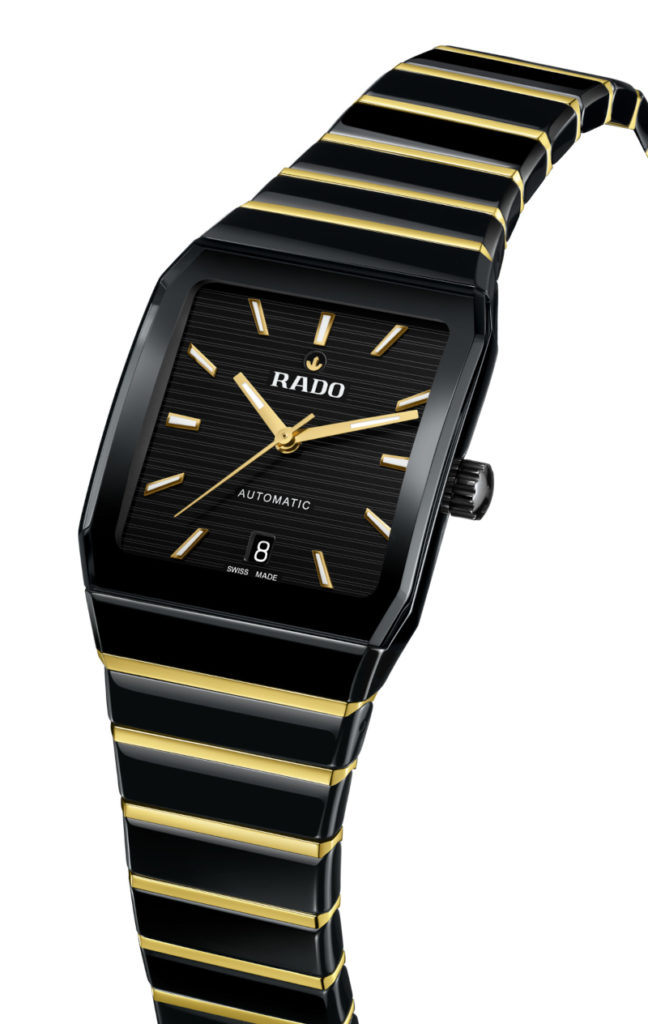
Although the Anatom was relaunched late in 2023, it is only this year that we have decided to put the collection on the cover of World of Watches Malaysia. And this is because, when the new Anatom debuted in 2023, it came paired with a rubber strap. The original Anatom from 1983 was paired with a bracelet, and so it was only apt that we waited for an Anatom with a matching bracelet before truly celebrating its revival. Rado’s CEO, Adrian Bosshard, made it clear that there was always meant to be a bracelet for the Anatom, but due to the complexity of making a bracelet out of ceramic, they couldn’t make it in time for the collection’s 40th anniversary. Earlier this year, however, the bracelet option finally came to Malaysia, and it changed the look of the watch completely.
What is perhaps telling about the complexity of this Anatom bracelet is the fact that even as the watch was launched in 1983, Rado couldn’t make the bracelet with the same hardmetal material as the case. Instead, they chose to combine the hardmetal case with a bracelet crafted from the trusty stainless steel. For the modern revival, however, and in the current playing field, this simply wouldn’t cut it for a luxury wristwatch. And so, Rado spent countless hours in research and development to ensure that they would be able to create a bracelet in the same high-tech ceramic material as the case.
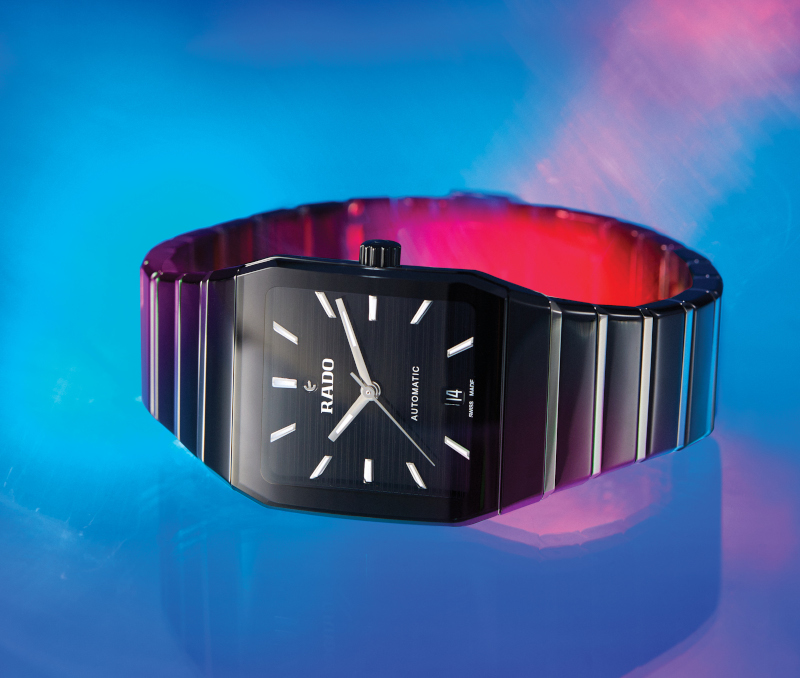
As mentioned earlier, the process of making these high-tech ceramic components isn’t as straightforward as working with something like stainless steel or precious metals. The sintering process, in particular, complicates things as not only does it undergo incredibly high temperatures, which sometimes alter the colours of pigments, but the entire material also shrinks during sintering, so engineers have to be incredibly precise in the control of this process. The bracelet is made of numerous links that are held together by metal components. Each of these links has to be made individually, and then considering that the bracelet tapers, the links will also have to vary in size. On top of all that, there is also a plasma high-tech ceramic version of this watch and bracelet, meaning everything will have to be treated with the same plasma level of temperatures, which is around 20,000°C.
The result, however, is well worth the effort, as if you put the version with the rubber and ceramic bracelets side by side, it looks worlds apart. The glossy links with the steel or gold-coloured parts in between really add to the design aesthetics that is familiar to the Anatom. And above all, the properties of ceramic that often feel warm and comfortable on the skin are now draped luxuriously around the wrist, making it even more a part of the human anatomy than ever before.
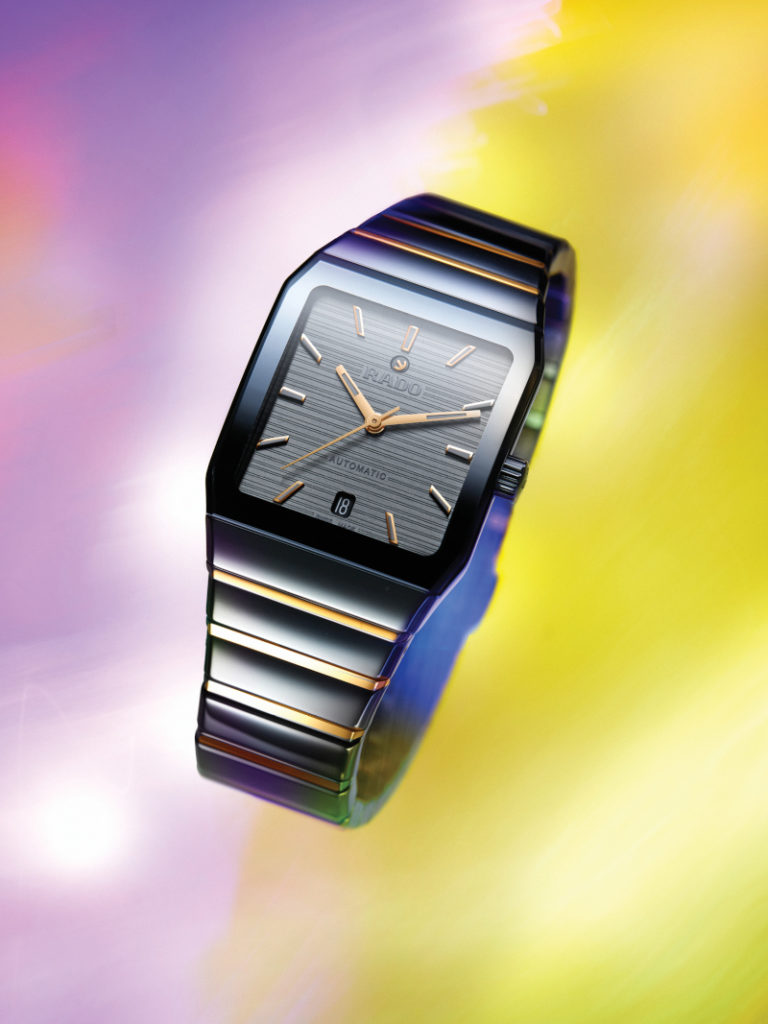
When the Anatom debuted in 1983, quartz was the latest in cutting-edge watchmaking innovation. Today, however, we expect our luxury watches to bring something more emotional to the table. Fittingly, the revived Anatom watch comes with a mechanical movement, its oscillating balance adding a “heartbeat” to the anatomy of the Anatom. And with it, a soul. The Rado calibre R766 movement trades oscillating frequency for power reserve, beating slightly slower at 3.5 Hz but extending its power reserve to a massive 72 hours. This 3-day power reserve is the sweet spot for many enthusiasts, as if you leave your watch fully wound on a Friday night, presumably to put on your sportier option over the weekend, the watch would still be keeping time come Monday.
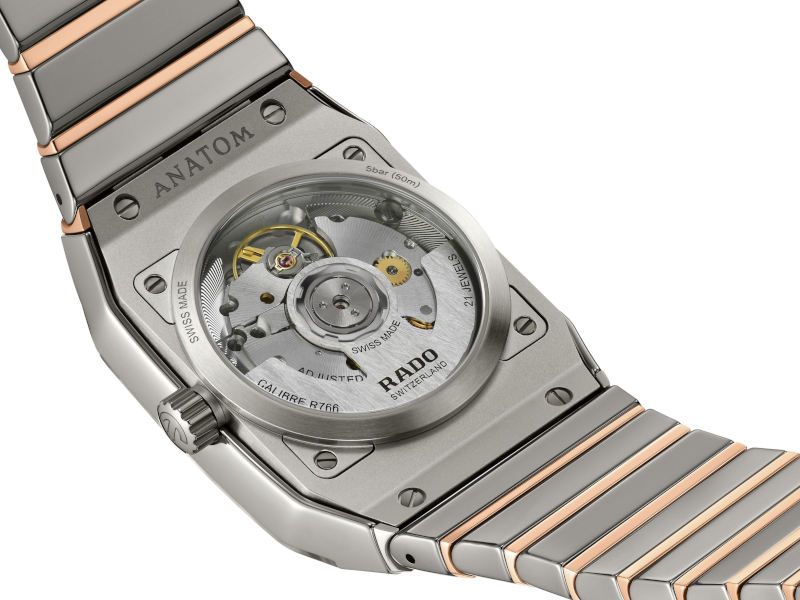
With the Anatom now fully revived and offering a plethora of choices, including the ceramic bracelet or rubber strap divide, and even the option of a Jubilé version which adds precious stones to a precious watch, the question we often ask is what is next? More recently, there have been summer colours added to the Anantom line with vibrant red, lime green and yellow dials that come with the rubber strap in matching colours. What would be interesting is if Rado starts taking all the beautiful hues they can achieve with the True Thinline Les Couleurs™ Le Corbusier and applies them to the retro-style design of the Anatom. For now, however, we still have a beautiful assortment of watches to choose from, the gleaming black high-tech ceramic and a personal favourite, the Anatom in plasma high-tech ceramic, as we wait for the next chapter of this retro revival story.
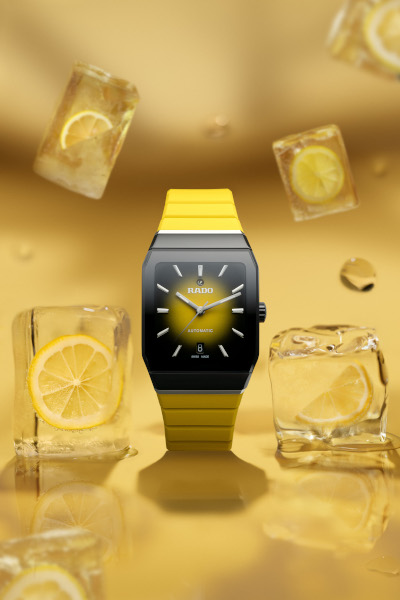
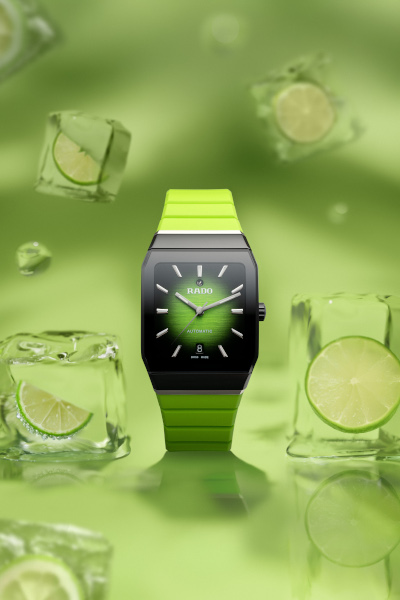
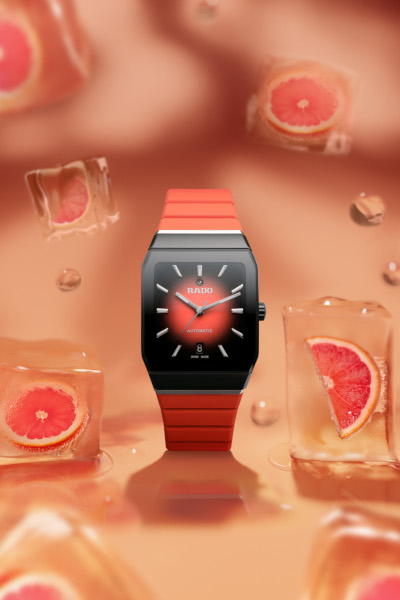
This article first appeard in the Summer 2025 issue of World of Watches Malaysia.